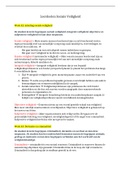Summary
Volledige samenvatting Introduction to Sociology
- Course
- Institution
- Book
Samenvattingen van alle hoofdstukken van 'Introduction to Sociology' van Frank van Tubergen. Het vak Inleiding in de Sociologie heb ik gevolgd in mijn eerste jaar van de Bachelor Sociologie aan de Radboud Universiteit.
[Show more]













